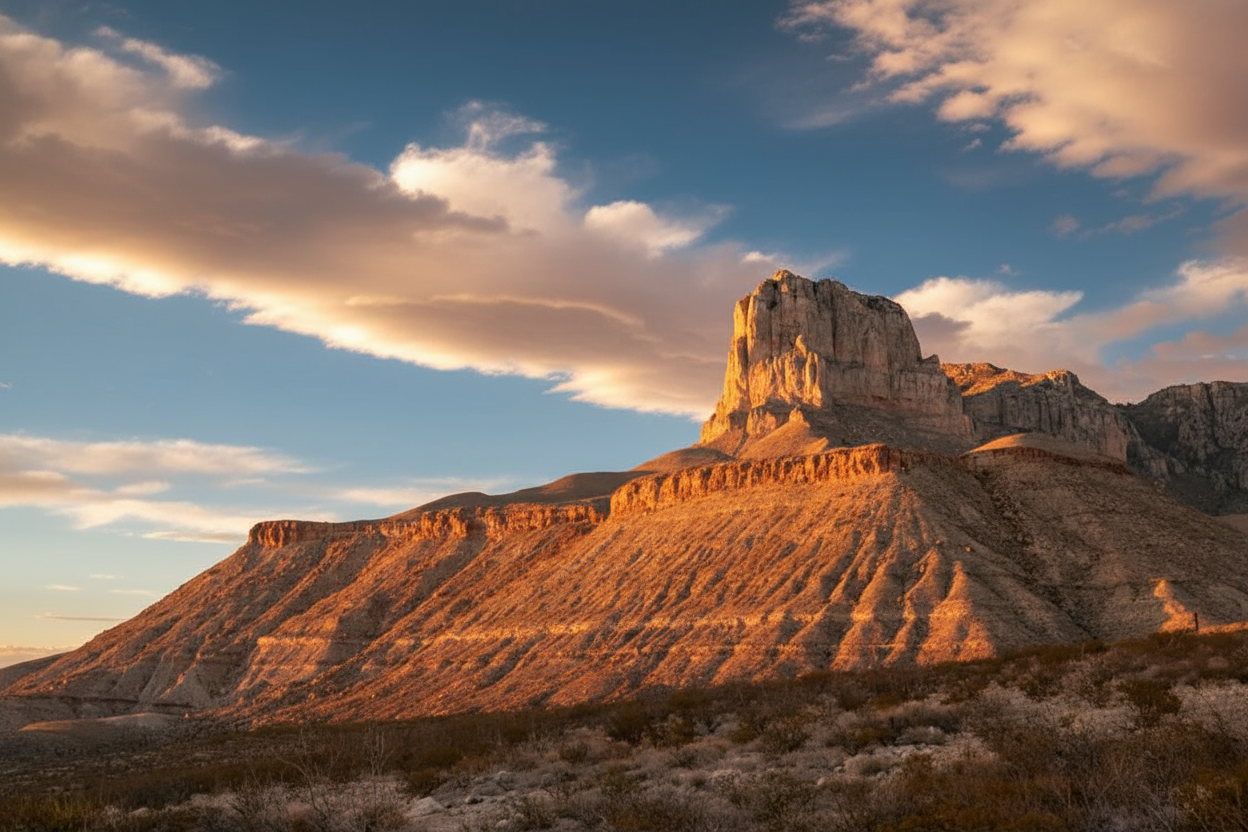Introduction: The Wildest Corner of Texas
Big Bend’s canyons, as sun rises on Guadalupe Peak, reveal a Texas both ancient and otherworldly. Welcome to the wildest corner of Texas—where the Chihuahuan Desert meets mountains, and the sky stretches farther than anywhere else in the state. This is the Trans-Pecos, the westernmost, highest, and driest region in Texas.
Unlike the humid Pineywoods or the grassy plains of the Panhandle, the Trans-Pecos is a paradox: severe yet alive, vast yet intimate, a land that demands resilience from all who inhabit it. Here, fossil reefs tower as mountains, canyons trace ancient rivers, and spring-fed oases whisper of water hidden beneath stone.
In this guide, you’ll uncover the ecological diversity, rare wildlife, and untamed adventure opportunities that make the Trans-Pecos one of the most scientifically and spiritually profound landscapes in North America.
Geography & Climate: The Skylands of Texas
Covering roughly 32,000 square miles—about one-eighth of Texas—the Trans-Pecos stretches from the Pecos River west to the Rio Grande, touching New Mexico and Chihuahua, Mexico. It encompasses the Basin and Range Province, a maze of rugged mountains and broad arid basins formed by faulting millions of years ago.
This is where Texas touches the sky. Guadalupe Peak, at 8,751 feet, stands as the state’s highest point. The Rio Grande carves deep canyons like Santa Elena and Boquillas before turning south toward the Gulf.
The region’s climate ranks as the driest in Texas, averaging 8–14 inches of rain annually, though summer monsoon storms can transform desert basins into fleeting grasslands. The Trans-Pecos anchors the northern Chihuahuan Desert, whose boundaries extend far into Mexico, and whose ecosystem harbors remarkable biodiversity adapted to drought and altitude alike.
Geological Wonders: Fire, Fossils, and Stone
Few terrains in North America rival the geological drama of West Texas. The Guadalupe Mountains preserve a fossilized reef from the Permian era—once an ancient sea, now standing 8,000 feet above the desert floor.
Farther south, the Chisos Mountains in Big Bend rise from volcanic origins, sheltering forests and canyons carved by eons of erosion. To the north, the Davis Mountains are remnants of ancient volcanoes that poured basaltic lava across the land.
Hidden among the basins are spring-fed oases like San Solomon Springs at Balmorhea State Park, where desert pupfish thrive in crystalline water. From the volcanic cliffs of the Sierra del Carmen to the limestone walls of Santa Elena Canyon, the Trans-Pecos reveals the earth’s artistry on an epic scale.
Desert Plant Communities
The Trans-Pecos proves the desert is anything but barren. Its signature plant, the creosote bush, perfumes the air after rain, while lechuguilla agave and ocotillo punctuate ridges with spiny drama.
Four main yucca species define the desert skyline—most notably Torrey, Soaptree, and Banana yucca, each sculpted by drought. The region bursts with cacti diversity: claret cup, prickly pear, cholla, and cochineal fill arroyos and hillsides with subtle blooms.
In the cooler, wetter Chisos Mountains, woodland communities emerge: pinyon pine, juniper, and oak forests host cloud-wrapped ecosystems unique within Texas. Remarkably, Big Bend alone harbors over 1,200 plant species—more than many entire states—showcasing the Trans-Pecos as a living museum of desert adaptation and resilience.
Signature Wildlife & Endemics
Wildlife thrives here in ways unseen elsewhere in Texas. Desert bighorn sheep, once extinct from the region, now scale cliffs following successful reintroduction programs. Javelinas, mountain lions, and even black bears prowl the rugged canyons.
Bird diversity astonishes: the roadrunner embodies desert cunning, while elf owls, Lucifer and Berylline hummingbirds, and the elusive Colima warbler attract birders from around the world.
Below the springs lie endemic aquatic treasures—Comanche Springs pupfish and Rio Grande cutthroat trout—relic species of ancient waterways. Among reptiles, the vivid clark’s spiny lizard and sleek Trans-Pecos rat snake underscore the isolation-driven evolution occurring across this vast desert.
Birding & Migration Hotspots
Every spring and fall, the Trans-Pecos becomes a flyway of motion. From Cottonwood Campground to Rio Grande Village, Big Bend transforms into a birder’s paradise where over 400 species may be spotted in a single season.
Standouts such as the Montezuma quail, Zone-tailed hawk, and Vermilion flycatcher make bucket lists for avian enthusiasts exploring West Texas. The best birding occurs from April–May and September–October, when desert skies teem with migrants refueling amid oasis groves and canyon streams.
Conservation Stories
Conservation in the Trans-Pecos tells stories of comeback and cooperation. Desert bighorn sheep reintroduction—once a dream—is now a triumph of science and perseverance. Black bears have naturally re-colonized Big Bend after decades of absence.
Efforts to protect crucial water sources like Balmorhea, San Solomon, and Phantom Springs secure life for both wildlife and local communities. Yet challenges persist: water scarcity, border infrastructure, and climate change all threaten fragile desert systems. Cross-border initiatives with Mexico now aim to restore river corridors and ensure shared resilience of the Chihuahuan biome.
Dark Skies & Stargazing
The Trans-Pecos hosts some of the darkest night skies left in North America. Big Bend National Park and Guadalupe Mountains National Park both hold International Dark Sky Park designations, while the McDonald Observatory in the Davis Mountains stands as a global center for astronomy.
Visitors can experience Star Parties, meteor showers, and naked-eye views of the Milky Way from the comfort of desert plateaus. These cloudless, low-humidity nights allow cosmic awe to shape human perspective—proof that in West Texas, the world’s ceiling is wide open.
Best Places to Visit & Adventure
- Big Bend National Park – Towering canyons, backcountry trails, and wild river adventures define this desert sanctuary.
- Guadalupe Mountains National Park – Texas’s highest peak, striking canyons, and fall foliage make this park essential for hikers.
- Davis Mountains State Park – Scenic loops, historic Fort Davis, and nearby McDonald Observatory anchor the region’s highland experiences.
- Rio Grande Corridor – Offers paddling through Santa Elena Canyon and exploration of spring-fed pools.
- Marfa, Alpine, and Terlingua – Artistic enclaves, ghost town charm, and local hospitality add cultural texture to wilderness adventures.
Seasonal Travel Guide
- Spring (Mar–May): Wildflowers bloom, migratory birds arrive, and days stay comfortably warm.
- Summer (Jun–Aug): Extreme heat limits mid-day activity; cave tours and spring-fed swims are ideal.
- Autumn (Sep–Nov): Peak hiking and birding season; brilliant fall colors in the Guadalupe Mountains.
- Winter (Dec–Feb): Cool temperatures and crisp skies make for perfect stargazing and solitude.
Planning Your Trip
Accommodation ranges from campgrounds and desert lodges to historic ranch stays. Always pack for extremes: wide-brimmed hats, sunblock, hydration gear, and layers for sudden temperature shifts.
Guided tours in birding, geology, and photography deepen understanding of the land’s wonders, while Leave No Trace ethics remain essential for preserving fragile soils and habitats. Certain areas, like Big Bend backcountry, require permits—plan in advance to ensure safe, ethical exploration.
Conclusion: Protecting Texas’s Final Frontier
The Trans-Pecos stands as more than a region—it’s Texas in raw form: sky, stone, and survival. Its wilderness invites awe, its biodiversity demands protection, and its endless horizons call travelers to rediscover what wildness truly means.
Subscribe for seasonal guides, stargazing updates, and conservation alerts, and join those safeguarding this last, luminous frontier of Texas.


